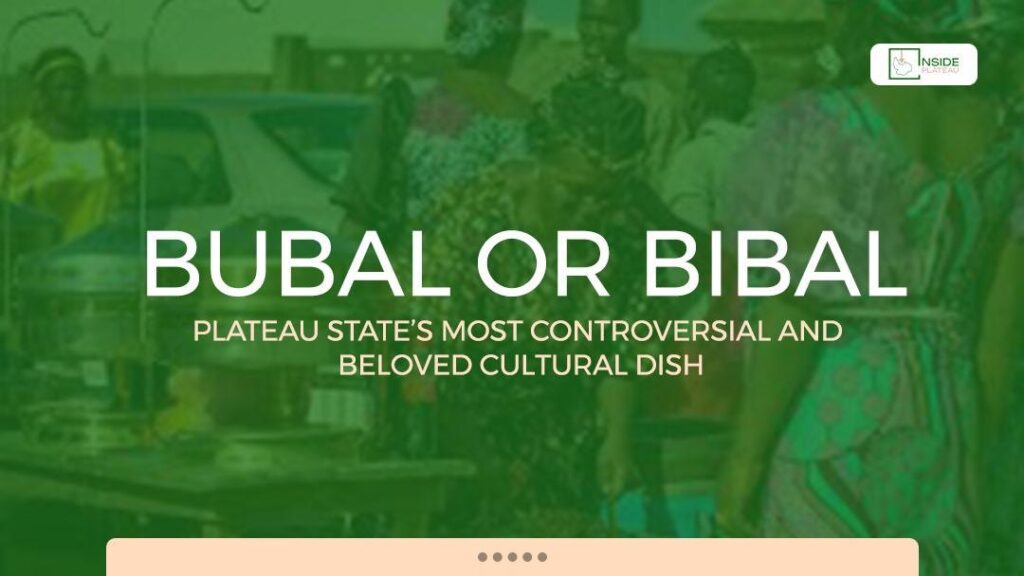
Few things get Plateau people talking like this dish. Is it Bubal? Or Bibal? The Ron tribe will tell you one thing, the Kulere another, and in Mushere, you’ll hear a different story altogether. The Mwaghavul have their claim, the Berom and Ngas serve it proudly, and the Tarok people place it on their tables with equal pride.
Ask around and you’ll be pulled into an endless, good-natured argument about names, ownership, and the true custodians of this delicacy. And you know what? That’s exactly what makes it beautiful.
This is not just food: it’s identity, memory, and pride, served hot in every home. Almost every tribe has an affiliation with it, and every family seems to have their own spin on how it should be made.
What is Bubal (or Bibal)?
Strip away the arguments and you’ll find a surprisingly simple core: kidney beans, black sesame seed (beniseed), and palm oil. No fancy seasonings, just earthy, hearty goodness which some people call the “natural sweetness of the bean.” Traditionally, it’s not your everyday meal but a dish for weddings, festivals, and cultural gatherings; the kind of food that brings people together across Ron, Mushere, Kulere, Mwaghavul, Berom, Tarok, and beyond. But beyond that, nothing is straightforward.
Traditional Cooking Methods (Agree to Disagree)
If the “right” recipe is what you’re out to get, you are indirectly calling for another debate between tribes, kitchens, cook, and even final consumers. Why? Because everyone of these categories who lay claim to this special dish has their own preferred way of making it. But, among these controversies, one fact stays true: the bean takes longer to cook than the black-eyed pea more commonly known across the country. And so the cooking process itself begins at a crossroad.
Cooking the Bean
One cook laughed as she told me, “That bean stays long before it softens.” Some households set their pot on the fire (usually a hearth outside) overnight, sieving the beans in the morning before giving them a final boil. Whereas, others use potash to soften the beans faster on instances where the option of cooking overnight does not appeal to the cook. These days, there are those who cut corners with a pressure pot and swear it works just as well. Once the beans soften, drain and rinse until the water runs clear.
Preparing the Sesame
Sesame (locally called ridi) is another story entirely. While everyone agrees that it must be fried until it smells like groundnut and crunches under your teeth, opinions split afterwards. While some pound it with seasoning cubes, salt and pepper for enhanced flavour, others refuse seasoning completely. Their defense: “why spoil a dish that already has its own natural flavor?”
Either ways, the pounded sesame is folded into the softened beans in a large bowl and stirred until everything blends together perfectly.
Adding Oil
And then comes palm oil, the soul of the dish. In some kitchens, it is fried first until it releases its aroma, then, a generous quantity is stirred into the bowl of beans mixed with ridi. For others, frying is seen as unnecessary, even harmful to the taste. Instead, the hot beans do the melting, blending with fresh, natural palm oil straight from the orchard.
While it may seem like the palm oil is the king of this dish, in some cultures like the Ngas and Berom tribes where African elemi oil is hallowed, the palm oil is completely replaced by this choice oil (more commonly known as mai atili or atili oil). In this case, the oil is not fried, but casually stirred into the mix with moderate precision.
Onions… or not
Don’t even get people started on onions. Some love them fried in oil, others toss them in, raw, for a sharp bite, while a few won’t touch onions at all. Every family has its rulebook, but in the end, they all have a jolly feast served warm and generously on a round table.
A Shared Taste of Home
Beyond the methods and arguments lies something deeper: memory. One woman shared fond memories of her maternal grandfather’s palm orchard. In her home, the oil used for bubal was always pure and golden, never adulterated. “The process was always long and tedious, yes, but worth it in the end,” she mused.
In Bokkos, the dish is prepared in generous pots during weddings and festivals. Among the Mwaghavul, Berom, and Tarok, it graces tables during special occasions, carrying the same weight of heritage and pride. Everywhere you turn, it is tied to culture: this is not just food you eat; it’s food you share, food that binds, food that reminds.
A Plateau Cultural Heritage
So, is it Bubal? Or Bibal? Is it a Ron specialty, a Kulere gem, a Mushere pride, or a Mwaghavul, Berom, Ngas or Tarok delicacy? The truth is, it’s all of these and more. Each tribe has shaped it, each family has refined it, each cook has added their own signature.
And maybe that’s the point. The richness of this dish isn’t in finding one “authentic” recipe. It’s in the many hands that stir the pot, the many stories that flavor it, and the many memories it carries. It is, in the end, Plateau on a plate: diverse, debated, but shared by all.
Now that you know its story, why not taste it for yourself? Whether you call it Bubal or Bibal, cook it with palm oil or atili, onions or none at all, one spoonful is a bite of Plateau’s heritage on your table.

